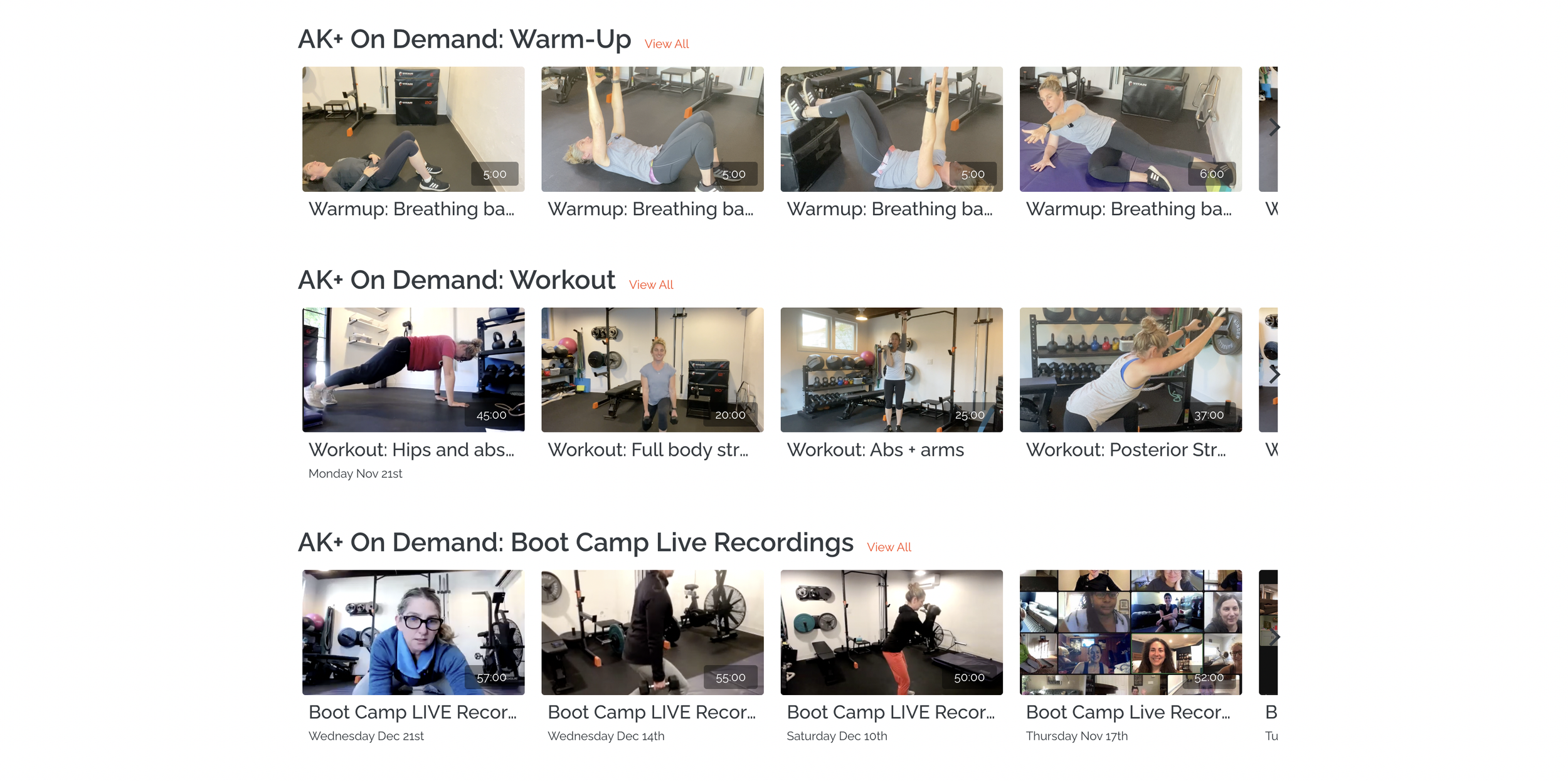The Best Video-on-Demand Platforms for Fitness and Yoga Studios
Note: I originally wrote this post in March 2020 and have updated it several times as the fitness tech industry has evolved. This version (written in Oct 2022) sums up my current recommendations for video platforms for fitness business owners. Every tool mentioned in this post is one I have experience with. This post contains affiliate links. If you subscribe to a service via a link in this post I may receive a small kickback which helps me continue to create content like this post. Thank you!
Is your studio primarily a brick & mortar fitness studio that offers video-on-demand on the side? Check out this article about Mindbody alternatives as well →
If you’re like most studio owners, the pandemic brought about a lot of changes to your boutique fitness business in a short period of time. A big part of that has likely involved offering clients more online options to stay connected.
Are you struggling to make sense of the wide array of options for video on-demand platforms?
Are you wondering if your current video on-demand platform is really the best for what you need?
You’re not alone. Many of us are faced with the challenge of using new technology and platforms to serve our clients in innovative ways.
…and if you thought the tech options for delivering virtual classes were plentiful before the pandemic, the industry has exploded since then—which is a great thing for fitness business owners.
Here, I’m going to break down a few of the different video on-demand platforms, their pros and their cons, and which one might be right for your fitness studio.
On-demand library, live stream, or courses?
Before we dig into the platform options, let’s break down the 3 types of video content that might be a player in your virtual fitness game-plan. Even though on-demand video libraries, digital courses and live streaming all involve video content, they require different tech set-ups with different benefits and challenges:
On-Demand Video Library: An on-demand library consists of pre-recorded videos or classes, workshops, etc, that clients can access at any time. This is usually a membership based product where the client can dip in and out of content as desired. It can be sold as a standalone product for an additional revenue stream, or is often included as a perk for top-tier membership levels.
Live Stream: A live-streamed video is exactly what it sounds like… it’s video footage that’s delivered to your clients as it’s happening, or in real-time. Live stream classes therefore, require a scheduling component as well where people can sign in for classes and be tracked and charged accordingly for attendance. Live stream classes are a popular option when you’re in person classes are at capacity, or something like a pandemic is in the way of people feeling comfortable coming to class in person.
Courses: Courses are on-demand content designed to be viewed in a linear fashion. Students progress through a curriculum starting with module 1 and with the goal to complete the content at some point. Courses are usually sold as a one-time purchase as compared to the monthly membership payments of an On-Demand Library. This is where you want to be if you’re offering online teacher training or certifications.
If you have not already defined which of the 3 video content types you plan to focus on for the future of your business, now’s the time to do that as it will make choosing the right tech partner a ton easier.
Want my personal thoughts on where this is all headed? If you believe the pandemic will eventually come to an end, and your studio doors will open again at full-capacity, on-demand video libraries and courses are what will continue to complement your in-studio classes - without complicating your pricing structure or your day-to-day operations. I’m not a particular fan of live stream classes as a long-term business plan. Having your instructors engage with in-studio clients and online viewers (at a high level) during the same class is nearly impossible. It’s a lot more feasible to film and make it available on-demand later on.
Is having a virtual component worthwhile for my studio?
At home workouts may have gained popularity since the pandemic, but it’s certainly not a new idea, and the concept is probably not going away anytime soon so it remains an opportunity in the market for businesses big and small. Here are several reasons to incorporate some sort of virtual component into your future studio plan:
Membership retention. A well-rounded video library is a great retention tool for your clients if you include it as a membership perk. It may be all the encouragement some clients need to upgrade from class passes or lower membership tiers.
Increased adaptability. Creating a robust video compilation now will make you more adaptable and resilient to market fluctuations in the future - whatever those may look like.
Additional revenue stream. For students who aren’t able to come into the studio regularly for classes, a virtual membership, course, or at-home challenge can ultimately expand your studio’s reach.
A stronger brand. Being able to take part in sessions from home, or while traveling at their convenience will likely make you a bigger part of your client’s overall lifestyle. In turn, this increases your brand strength with little additional effort on your part.
More efficient trainings. If teacher training or other certifications are a significant revenue stream for your studio, moving a portion of the curriculum online can save your in-person hours and facility usage for the more hands-on modules.
Video on-demand platforms: You’ve got options.
Not worried about controlling access or monetizing your videos? You may be just fine with a simple solution - a private Facebook group or password-protected page on your website will likely suffice.
But if you’re looking for something a little more elegant, there are many options you can use to establish additional revenue streams and control client access. I’ve compiled a list of some of the best virtual studio platforms out there. These recommendations are based on several factors, including:
Cost
Ease of setup
Ease of day-to-day use and maintenance
Simplicity on the customer’s end
Branding possibilities
Flexibility to use for marketing purposes and digital product sales
Trustworthiness of the platform
Note: If you operate a hybrid studio and want your clients to have a single login for all aspects of your business, the only way to do that is to keep your virtual offers on the same scheduling platform as your in person ones. If that’s your priority, and you offer both in person and virtual classes, skip below to look at the following: Walla, Mindbody Virtual Wellness and arketa. All others on this list are NOT set up to also schedule your in person classes. Using another studio scheduler? Check with them first on virtual options as sensitive info like username and passwords are not able to be moved between platforms!
Recommended Video platforms for fitness and yoga studios
This list is certainly not exhaustive—there are a lot of great platforms out there, but taking the elements above into consideration, here are my recommendations for most fitness and wellness studios I work with.
Uscreen
It might be for you if…
You want a standalone video library platform, easy set-up, and a trusted platform that can grow with your subscription-based business
The Highlights
Cost is $49/mo if you pay annually ($99/mo if month-to-month) + $.50/subscriber
Pros: UScreen is an established platform in the video product space. It’s clean, straightforward library has a nice grid-style view that can also be grouped into categories or playlists. You can sell via one-time sales, subscriptions or rentals, and can easily create a customized and branded sales page using one of their templates. You can get up and running very quickly. And while this basic plan is a good fit for most studios, UScreen does have options at various pricing levels for expansion into custom apps and more. A primary competitor of Vimeo ott, UScreen wins out for me for several reasons, but a big reason is that their customer support is known to be excellent. Not yet as big as vimeo, they are more than available to help walk you through the set-up (the founder himself even got on a call with me)
Cons: Unfortunately, the ability to add drop-down filters is only available on their AMPLIFY plan or higher. You also won’t be able to offer any content other than video from your library, so this may not be a good fit for things like teacher training curriculum (where you’ll want corresponding text + pdf workbooks as part of the included material). The per subscriber fee also makes this not a good choice if you want to offer free videos on the platform as part of your marketing strategy (although free trials are an option for this!)
How to get started: Create a free trial and see what it can do. Also, check out this resource they created specifically to help fitness studios get up and running
Offering Tree
It might be for you if…
You are looking for an all-in-one platform that can do VOD, live class bookings and more all at a very affordable price point.
The Highlights
Cost is $29/mo for OfferingTree + 1.9% transaction fee or $59/mo + 0% transaction fee.
Pros: The greatest strength of OfferingTree is all of the options and flexibility for the price point. You can sell recurring subscriptions as well as single-purchase videos, products and courses. You can also offer videos and other products for a donation or for free. All of your digital content can be stored on their platform for no additional fee which is amazing. You can add your own custom filters to your VOD library and it also has built in search even on the base plan. Another perk is that OfferingTree also has booking software if you are hosting live streamed or in-person classes or take private one-on-one appointments.
Cons: OfferingTree uses Stripe to process payments and so far that is the only payment solution offered. Stripe does work in a lot of countries and does support 135+ currencies.
How to get started: Create a free 14-day trial account here*. Want help creating a OfferingTree-integrated Squarespace website for your business? Get it touch, I’ve got a special service package available for this.
*Use that link to start your trial account and you’ll get 50% off your first 3 months or 15% off an annual plan—thanks to OfferingTree for offering that to Pixality blog readers!
Arketa
It might be for you if…
You want a virtual or hybrid studio platform that gets close to doing it all: livestream classes, in person classes, video on demand memberships, single sale video bundles + community challenges.
The Highlights
Cost is $25/mo + 3% transaction fees + Stripe fees
Pros: Arketa emerged out of the pandemic and has quickly risen to the top of the heap for virtual studios and personal trainers looking to build a community online. They focus solely on the fitness industry and have built a feature set that allows for a lot of flexibility in how you package and sell your classes and videos. The design is clean and modern as well and provided website widgets allow your clients to stay on your website to both buy and view videos.
Cons: Arketa is a start-up in a competitive post-pandemic space. Their focus on virtual fitness alone (which is part of what makes them great) also makes them a little risky as a platform. Feature development has been fast so things are a little buggy at times.
How to get started: Book a demo here
Instill Video
It might be for you if…
You want a premium-looking, white-label solution for your subscription-based business model. Instill is capable of handling all forms of your content, whether it be on-demand videos, live-streaming classes, daily schedules, or months long programs. With it’s clean and customizable look, your customers can easily navigate through your content with custom filters, programs, and favorites. Created and backed by AE Studio, the technology is always evolving with new integrations and features.
The Highlights
• Cost starts at $99/month
• Pros: Create your own filters, programs, challenges, and playlists. Manage your customers, branding, and revenue on the easy to use admin. Take your classes live with embedded streaming and live chat feature. Instill also offers custom mobile apps for your workouts as well.
• Cons: If you’re looking to manage and train 1:1 students or incorporate in person classes, Instill might not be the best fit. With the price per user model, if you want to offer free content, this platform might not make economic sense. Focused on a subscription model, Instill doesn’t work for one-time purchases for programs.
• How to get started: Learn more and create your account here.
It might be for you if…
Your brand has a strong educational element and you want more traditional course-like features - with an easy set-up on a trusted platform.
The Highlights
Cost is $99/mo + stripe fees.
Pros: This easy to use platform has lots of benefits if you’re looking to go beyond just video content. For example, you can include workbooks or other material with videos, create courses with multiple lessons and modules, and offer quizzes. Teachable provides a more classic learning experience in contrast to the simple video gallery like UScreen or Vimeo ott. It also supports both subscriptions and one-time purchases and offers quick and easy setup. Here’s an example of a yoga studio using Teachable.
Cons: Since it’s not typically used for fitness businesses, it can be harder to navigate around for on-demand videos only. It does not have a layout that allows users to filter thru a gallery of videos by class type or length, for example.
How to get started: Head to https://teachable.com/ and create an account.
Other Options to Consider
Mindbody Virtual Wellness Platform
It’s hard to beat total integration with your existing scheduling software! The Mindbody Virtual Wellness Platform, which offers both on-demand and livestream capability is the only option if you use Mindbody for in person bookings and want to have the same login credentials for your clients to access your virtual offerings.
Walla
If your studio is primarily in person but you want to offer livestream and VOD memberships as well, Walla may be your new favorite. A recent start-up in the studio scheduling space, Walla designed their platform from the ground up for both seamless in person + virtual ops. (single login credentials for your clients is a big plus here!) One to watch for sure!
Marvelous (aka Namastream)
This platform is a good option, especially if you want the flexibility of offering both live-stream and on-demand content. It feels a lot like Teachable, but it’s slightly more expensive and includes live-stream capabilities built-in. They do also have a video-gallery grid view that Teachable is missing. It was originally designed specifically for yoga businesses, so you may find their support articles a bit more helpful and relevant as well.
Squarespace Member Areas
Released in Nov 2020, you can now protect content on your Squarespace website without any other third party tool! The catch with this is you must build everything on your site yourself—your content starts with a blank web page. If you’re looking for the ultimate in customization and want that flexibility, and to keep it all on your website, then Squarespace Member Areas may be a good option. It’s pretty limited in the way you package and sell your content compared to the option platforms on this page, but it’s still a great option to have and may be good for some studios with simple pricing models.
Pro tips:
When getting software demos, if you’re looking to replace or drop tools, don’t forget to ask about other features that may be important for your business: a mobile app, reporting, payroll, sub management, email / text marketing integrations to name a few!
Be sure to think about where you want your virtual fitness business to be in the future. What software is one you can grow with and provides support along the way?
Still need some help sorting through your options? Ready to get your website looking its best to improve your client’s online studio experience? Book a consulting call and we’ll come up with a plan.
You may also like:










